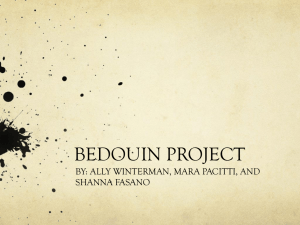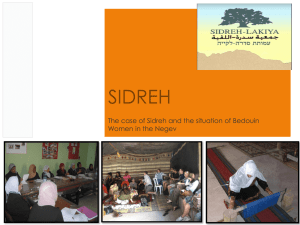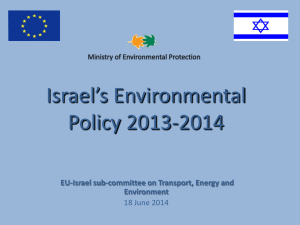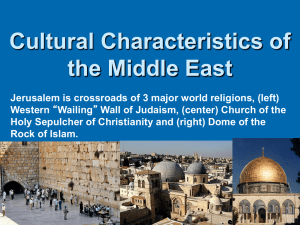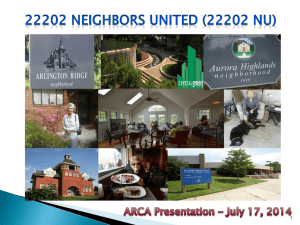Adalah and the Negev Coexistence Forum
advertisement
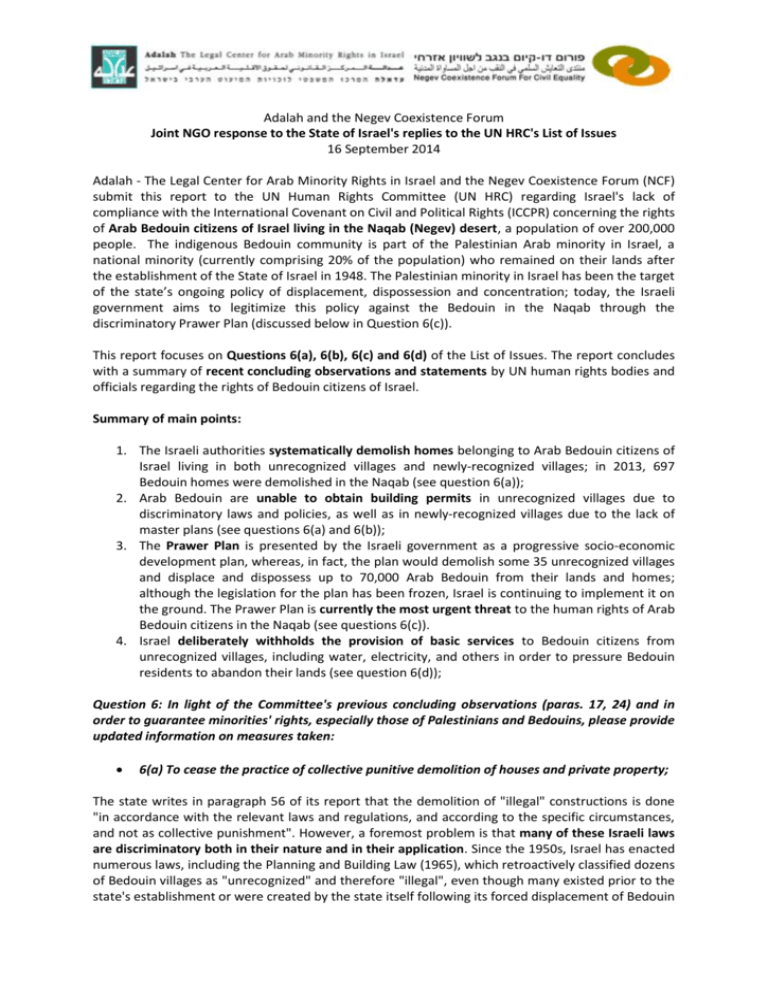
Adalah and the Negev Coexistence Forum Joint NGO response to the State of Israel's replies to the UN HRC's List of Issues 16 September 2014 Adalah - The Legal Center for Arab Minority Rights in Israel and the Negev Coexistence Forum (NCF) submit this report to the UN Human Rights Committee (UN HRC) regarding Israel's lack of compliance with the International Covenant on Civil and Political Rights (ICCPR) concerning the rights of Arab Bedouin citizens of Israel living in the Naqab (Negev) desert, a population of over 200,000 people. The indigenous Bedouin community is part of the Palestinian Arab minority in Israel, a national minority (currently comprising 20% of the population) who remained on their lands after the establishment of the State of Israel in 1948. The Palestinian minority in Israel has been the target of the state’s ongoing policy of displacement, dispossession and concentration; today, the Israeli government aims to legitimize this policy against the Bedouin in the Naqab through the discriminatory Prawer Plan (discussed below in Question 6(c)). This report focuses on Questions 6(a), 6(b), 6(c) and 6(d) of the List of Issues. The report concludes with a summary of recent concluding observations and statements by UN human rights bodies and officials regarding the rights of Bedouin citizens of Israel. Summary of main points: 1. The Israeli authorities systematically demolish homes belonging to Arab Bedouin citizens of Israel living in both unrecognized villages and newly-recognized villages; in 2013, 697 Bedouin homes were demolished in the Naqab (see question 6(a)); 2. Arab Bedouin are unable to obtain building permits in unrecognized villages due to discriminatory laws and policies, as well as in newly-recognized villages due to the lack of master plans (see questions 6(a) and 6(b)); 3. The Prawer Plan is presented by the Israeli government as a progressive socio-economic development plan, whereas, in fact, the plan would demolish some 35 unrecognized villages and displace and dispossess up to 70,000 Arab Bedouin from their lands and homes; although the legislation for the plan has been frozen, Israel is continuing to implement it on the ground. The Prawer Plan is currently the most urgent threat to the human rights of Arab Bedouin citizens in the Naqab (see questions 6(c)). 4. Israel deliberately withholds the provision of basic services to Bedouin citizens from unrecognized villages, including water, electricity, and others in order to pressure Bedouin residents to abandon their lands (see question 6(d)); Question 6: In light of the Committee's previous concluding observations (paras. 17, 24) and in order to guarantee minorities' rights, especially those of Palestinians and Bedouins, please provide updated information on measures taken: 6(a) To cease the practice of collective punitive demolition of houses and private property; The state writes in paragraph 56 of its report that the demolition of "illegal" constructions is done "in accordance with the relevant laws and regulations, and according to the specific circumstances, and not as collective punishment". However, a foremost problem is that many of these Israeli laws are discriminatory both in their nature and in their application. Since the 1950s, Israel has enacted numerous laws, including the Planning and Building Law (1965), which retroactively classified dozens of Bedouin villages as "unrecognized" and therefore "illegal", even though many existed prior to the state's establishment or were created by the state itself following its forced displacement of Bedouin tribes into the 'Siyag' zone. As a result, the Bedouin residents of the 35 unrecognized villages cannot acquire building permits or obtain plans for housing, and are therefore subject to Israel's house demolition policy, amounting to collective punishment. In addition, residents of 13 recently-recognized Bedouin villages continue to find it extremely difficult to obtain building permits or expand their municipal borders due to the state's deliberate efforts to minimize Bedouin communities and their lands. In contrast to both the unrecognized and newly-recognized Bedouin villages, the state retroactively legalizes homes and towns built by Israeli Jewish citizens in the Naqab and continues to allow the construction of homes without punishment, even those built without initial permits or plans.1 Israeli planning laws are therefore selectively and deliberately applied to discriminate against the Arab Bedouin community in the Naqab. Within this context, the Israeli authorities have intensified demolitions of Bedouin homes and property in recent years in order to forcibly displace entire communities into government-planned towns in the Naqab, namely under the framework of the "Prawer Plan" (see response to Question 6(c) below). The policy of house demolitions aims to 'encourage' Bedouin citizens to accept the state's forced urbanization plan. The 2013 annual report of the Coordination Directorate of Land Law Enforcement in the Negev (CDLLEF), which is the specialized security unit responsible for “enforcing land laws in the Negev”, reveals that the unit demolished 321 houses and structures in Bedouin villages in that year. In addition, 376 houses and other structures were self-demolished by their owners in 2013.2 Another example of the punitive and discriminatory nature of the state's demolition policy is its practice of using these means as punishment of Bedouin citizens making modest renovations or even minor repairs to existing structures. In January 2013, a family in the unrecognized village of Dahiyya was penalized for adding three steps to a doorway, after suffering damage from a severe storm. Residents of these villages fear carrying out repairs to their homes since this could result in a demolition order.3 The statistics on home demolitions also indicate a growing phenomenon of "self-demolitions", which are the direct result of oral "threats" by state authorities to pressure Bedouin residents into destroying their own homes. State authorities threaten residents that unless they carry out demolitions themselves, they will be charged for the costs of the bulldozing and/or eviction, which can amount to thousands or tens of thousands of Israeli shekels.4 Many residents, fearing for their belongings, building materials and financial welfare, ultimately choose to conduct these selfdemolitions in order to avoid the state's additional financial penalties and the loss of their possessions. As a result, nearly half of the Bedouin homes destroyed in 2012 and 2013 were demolished by their owners, rather than by the state, and have also constituted the highest number of self-demolitions of Bedouin homes ever reported in the Naqab. 1 The Negev Individual Settlements-Negev Development Authority Law, Amendment No. 4 (2010) allows for the retroactive recognition of dozens of individual settlements/ farms in the Naqab, which were established without permits and contrary to planning laws (all but one are owned by Jewish Israeli families), and afford the settlements with official status: http://www.adalah.org/eng/?mod=db&dld_page=law&slg=negevdevelopment-authority-law-1991-individual-settlements-amendment-no-4. 2 The Coordination Directorate of Land Law Enforcement in the Negev, 2013 annual report. The CDLLEF is a new unit established by the Ministry of Public Security in 2012, charged with executing home demolitions exclusively in Bedouin villages in the Naqab (Government decision no. 3707, 11 September 2011). 3 For details see NCF report: Bedouin House Demolitions in the Negev 2012/2013, p.26: http://www.dukium.org/eng/wp-content/uploads/2011/06/HD_Report_E_2014.pdf. 4 Ibid. 2 6(b) To review the State party's housing policy and the issuance of construction permits, to ensure that municipal planning systems are not discriminatory…; The underlying municipal planning system in the Naqab is the discriminatory Regional Master Plan for the Be’er Sheva Metropolitan Area, which was approved by the government in August 2012 despite outstanding objections by the Bedouin community. The Master Plan sets out the state’s development plans for the Be’er Sheva Metropolitan area, and outlines in concrete terms the eviction and destruction of most of the 35 unrecognized villages. The Prawer Plan, which will be discussed below in question 6(c) serves to legitimize and facilitate the "development-induced displacement" confirmed in the Master Plan. Such displacement is urgent and ongoing as in the case of the repeated demolition of the village of Al-Araqib, whose residents are being dispossessed of their land to make possible the planting of hundreds of thousands of saplings in the Jewish National Fund’s Ambassadors and God-TV Forests.5 The Master Plan approved the extension of Route 6, the major toll road in Israel, which is also already under construction and is planned to destroy and/or divide the villages of El-Masadiya, El-Qrin, Khirbat Al-Wattan, Bir Al-Hamam, Khashem Zane, Wadi elNaam and Wadi el-Mashash.6 Similarly, in Umm el-Hieran, the state plan has approved that the a new town of "Hiran" will be established in its stead; and in neighboring Atir, the Yatir Forest will soon be expanded over top of Bedouin village (see below question 6(c)). The Master Plan sets the discriminatory framework in the Naqab for ensuring state control over maximum land for the Jewish people with the minimum amount of Palestinian-Bedouin. Attempts by the Bedouin community, together with civil society partners, to propose an Alternative Master Plan for the Naqab have been rejected.7 The Alternative Plan outlines in practical terms and on the principles of equality and non-discrimination, the recognition of the unrecognized villages. The Alternative Plan is grounded in Israeli planning principles and ensures an end to the devastating home demolitions and the systemic denial of basic services, and provides the opportunity for the Bedouin community to live with dignity in their homes and on their ancestral land. Israel has shown no urgency in solving the land planning problems in the Bedouin villages in the Naqab, even in the 13 "recently-recognized" villages, which were granted official status over the past decade; the first village was recognized in 2003. Despite this recognition, which was supposed to provide these villages with services, infrastructure and detailed planning, very little has changed on the ground. In practice, due to the lack of official plans, the denial of building permits continues and thus so too does the policy of house demolitions.8 As such, the residents of these recently-recognized villages remain subject to similar forms of discrimination as those in unrecognized villages. New houses that are built to accommodate a village's population growth, and houses that have undergone even minor renovation or repairs, are still considered to be illegal and are subsequently demolished by the Israel Land Authority (ILA) and the Ministry of Interior.In contrast, during the same decade, many new Israeli Jewish settlements were established in the Naqab and were immediately able to acquire appropriate outline plans, and suffered no problems regarding the acquisition of building permits and provision of services. 5 See Adalah Position Paper, “From Al-Araqib to Susiya” (2013), available online at http://adalah.org/Public/files/English/Publications/Position_Papers/Forced-Displacement-Position-Paper-0513.pdf; see also, Dukium resources, “Al-Arakib”, available online at http://www.dukium.org/eng/?page_id=882 6 See Jerusalem Post, “Bedouin ask court to move Route 6 southward”, 13 May 2010, available online at http://www.jpost.com/Israel/Beduin-ask-court-to-move-Route-6-southward. 7 Alternative Plan: http://bimkom.org/eng/wp-content/uploads/Bedouin-Negev-Alternative-Master-Plan.pdf. 8 Between Discrimination and Abandonment: The Bedouin Recognized Villages and the Jewish Settlements in the Negev, March 2014. http://www.dukium.org/eng/wp-content/uploads/2014/04/IDERD_English.pdf. 3 The state has also been deliberately negligent in providing construction permits and helping the development of these recently-recognized Bedouin villages. For example, according to official data, plots for buildings are available in only 7 out of the 13 recently-recognized villages.9 However, in 5 of the 7, not one lot has been developed or marketed. In Abu Krinat, recognized since 2003, only ten lots were developed and marketed. In Al-Sayed, recognized in 2006, six lots have been marketed but none developed. Only in Tarabin A-Sana, have hundreds of lots been developed and marketed. In the other four villages where the State claims lots are ready, no lot has been marketed. With the exception of Tarabin A-Sana, almost no lots have been marketed in villages with thousands of residents.10 In a situation whereby the absence of a lot prevents the acquisition of a building permit, and where lots were actually marketed in only three villages, residents have no choice but to build on their own despite the lack of permits. 6(c) To recognize and promote the Bedouin population's right to ancestral land and traditional livelihood. In this regard, please provide detailed information on the situation of the unrecognized Arab-Bedouin villages and indicate measures that have been taken to stop the demolition of houses and indicate whether the State party envisages withdrawing the proposed Law for the Regulation of the Bedouin Settlement in the Negev. The state writes in paragraph 86 of its response that about 86,000 Bedouin "still choose to live in unauthorized clusters of buildings throughout the Negev, while ignoring the planning procedure of the planning authorities in Israel". As noted above, the 35 unrecognized Bedouin villages of the Naqab were declared illegal due to the Planning and Building Law, even though many existed prior to the establishment of the state or were created by Israeli military order in the 1950s. In both cases, these villages pre-dated the laws that declared them illegal. Thus, while the state employs a discourse in its report of these villages as "unauthorized clusters", "the Bedouin diaspora", or "illegal villages", it is in fact discriminatory Israeli laws and policies that unjustly define them as such. Numerous other land and housing laws are further used to target the land rights of Arab Bedouin citizens and uphold the privileged rights to housing for Jewish citizens of Israel. These laws do not meet the basic human rights of Bedouin citizens as defined by the ICCPR and other international laws, and fail to recognize the status of the Arab Bedouin as an indigenous population with rights enshrined long before the state's existence. Recently, an Israeli court formally recognized the deficiencies of the state’s policies in the unrecognized villages and acknowledged the fact that a particular Bedouin village indeed pre-dated the establishment of the state of Israel in 1948. In a precedent-setting ruling in May 2014, the Be'er Sheva District Court rejected the state's appeal to overturn a lower court's decision to cancel 51 home demolition orders against residents of the unrecognized village of Alsira. In the ruling, the judge wrote: "The appeal revolved around a village that was built before the establishment of the state, and has existed since without any problem…there would need to be a strong and genuine public interest to justify the need for uprooting 350 people from their homes and displacing them".11 The court thus acknowledged that the village was in fact a permanent village belonging rightfully to citizens of Israel, not a temporary "unauthorized cluster" as the state repeatedly insisted. The state also writes in paragraph 86 that the presence of these villages "causes many difficulties in terms of providing services to the residents of these unauthorized clusters". This claim is misleading 9 Ibid. Ministry of Justice, Annexes Attached to the 4th Periodic Report by the State of Israel before The Committee on Civil and Political Rights, July 2013, p. 5. 11 Adalah press release, "Be'er Sheva District Court rejects state's appeal; demolition orders against Arab Bedouin village of Alsira remain cancelled", 3 May 2014: http://adalah.org/eng/Articles/2273/Be%E2%80%99er-Sheva-District-Court-rejects-state%E2%80%99s-of. 10 4 as the state has consistently supplied Israeli Jewish citizens with services and infrastructure across the Naqab; some "individual settlements” or single-family farms, which were retroactively legalized by the state, are even located close to Bedouin villages.12 A stark example of this is the Bedouin village of Umm el-Hieran. For nearly a decade, the state has been trying to demolish this village and forcibly remove its Bedouin residents, in order to build a new Jewish town called "Hiran" over its ruins.13 The Jewish citizens expected to move into the new town are currently camped in a makeshift trailer town within the Yatir Forest. This outpost is supplied with electricity, water and even state recycling services, while the settlers wait for the demolition of the village; these services have never been provided or promised to the Bedouin residents of Umm el-Hieran. An Israeli Supreme Court case is currently pending to determine whether the state's plans for Umm el-Hieran will be allowed to continue.14 The question before the court is: can the state destroy an Arab village to build a Jewish one in its place?15 Meanwhile, in the wider Naqab, the state openly offers Jewish citizens the choices of living and building in urban, rural, communal and individual settlements/family farms, all provided with water, electricity and other services. There is therefore no reason why the state cannot provide the unrecognized Bedouin villages with basic services as granted to Jewish communities. The aim of this policy of negligence is to force the Bedouin to abandon their lands. The state writes in paragraph 87 of its response that it is encouraging the movement of Bedouin citizens to "permanent towns" by offering financial benefits and compensation for the demolition of structures. Despite the state's attempts to use financial incentives for urbanization (which are unavailable to many community members because of the State’s assessment of the validity of their land ownership/title), many Arab Bedouin citizens have a distinctive and traditional way of life based on agriculture and herding, strong family ties and attachment to ancestral land. As an internationally-recognized indigenous people with rights guaranteed under international law, their choice to continue certain traditional ways of life should be acknowledged and respected by the state.16 Israel's forced urbanization program instead seeks to destroy this traditional lifestyle, with severe implications for the socio-economic fabric of Bedouin society. In addition, all the so-called “permanent towns” (7 towns that were planned by the government) suffer severely inadequate services and infrastructure. The decades-long policy of forced urbanization and the state's deliberate negligence of these towns have also contributed to the presence of the highest poverty and unemployment rates in the country, high crime rates, and other social-economic problems that are largely unaddressed by the state.17 Thus, while it is fair to offer Bedouin citizens the option of moving into a city or township, the state must allow the Bedouin to choose from a range of options, just as Israeli Jewish citizens have in the Naqab and elsewhere in the state, and not be pressured or deliberately compelled to make undesired choices. 12 See supra, Note 1. Adalah newsletter, "Can Israeli demolish an Arab village to build a Jewish one?", November 2013: http://us4.campaign-archive2.com/?u=4c0bb759968fd1dcd47869809&id=1994419b66; Adalah publication "Nomads Against their Will: The Examples of Atir-Umm el-Hieran", September 2011: http://www.adalah.org/eng/publications/Nomads%20Against%20their%20Will%20English%20pdf%20final.pdf 14 Case citation: HCJ 3094/11, Ibrahim Abu al Qian et al. v. The State of Israel. 15 Adalah press release, "Israeli Supreme Court hears Adalah's appeal against evacuation of unrecognized Arab Bedouin village Umm el-Hieran to build new Jewish town on its ruins", 25 November 2013: http://adalah.org/eng/Articles/2221/Israeli-Supreme-Court-Hears-Adalah%E2%80%99s-Appeal-of. 16 Amara, A, Abu Sa'ad, I and Yiftahel, O (eds), Indigenous (in)Justice, Human Rights Law and Bedouin Arabs in the Naqab-Negev, International Human Rights Clinic, Human Rights Program, Harvard Law School, Cambridge MA, 2012; See also, Report by the Special Rapporteur on the rights of indigenous peoples, James Anaya, Addendum Communications sent, replies received and follow-up, 22 August 2011, A/HRC/18/35/Add. 1 17 NCF report (2013): Accessibility of public and private services in Arab localities, and institutionalized discrimination against Arab public sector employees in the Negev. www.dukium.org/eng/wpconent/uploads/2011/06 racial discrimination_English_2013.pdf. 13 5 The Law for the Regulation of the Bedouin Settlement in the Negev is one of three components the proposed of the “Prawer Plan”, a discriminatory plan predicated on all the above misconceptions and racist objectives which aims to forcibly displace Bedouin citizens and concentrate them into the smallest area possible, in order to maximize land for Jewish citizens in the Naqab.18 The Prawer Plan is comprised of: 1) the underlying Be'er Sheva Metropolitan Plan (discussed above in question 6(b)); 2) the government's approved development and compensation scheme (the Prawer Plan); and 3) the proposed legislative arm of the Plan (The Law for the Regulation of the Bedouin Settlement in the Negev). During 2013, Israeli police arrested scores of Arab citizens in the Naqab and other parts of Israel who were protesting against the Prawer Plan.19 In December 2013, after months of intensified legal, international and popular opposition to the bill, and after the Israeli minister in charge of the Plan resigned and confirmed that the government had not consulted with the Bedouin citizens about the Plan, Israel announced the freezing of the Prawer bill in the Knesset. However, with the Be’er Sheva Metropolitan Plan still in place, the government is continuing to implement aspects of the plan on the ground, issuing demolition orders against Bedouin villages and destroying many homes and properties.20 The responsibility for the Plan was moved from the Prime Minister's Office to the Ministry of Agriculture under the supervision of Minister Yair Shamir. In January 2014, Shamir requested one month to review the Prawer Plan and its implementing legislation; to date, while Minister Shamir has met with some community members, no updates have been provided and home demolitions and displacement continue to be a daily reality for Bedouin citizens of Israel. If allowed to continue, the Prawer Plan will facilitate the mass dispossession of Arab Bedouin citizens in the Naqab, in severe violation of the principles and articles of the ICCPR. 6(d) To ensure the Bedouin...population's right to health services, education, adequate housing, water and sanitation. For this question, the state refers to its responses in Question 6(c) concerning the unrecognized villages and its financial plans for the recognized villages. This referral attempts to divert the Committee away from scrutinizing the state's responsibility for the almost non-existent provision of basic services to 90,000-100,000 Bedouin citizens living in unrecognized and recently-recognized villages, including health, education, housing, water, sanitation, public transportation, infrastructure and others. As noted above, because of the state's discriminatory refusal to recognize the rightful existence of these villages, these Bedouin citizens are consequently denied all these basic rights in direct violation of numerous articles of the ICCPR. This deliberate negligence by the state has made the socioeconomic conditions of these villages very dire. Any basic services provided in the unrecognized villages are a result of intensive legal action to ensure that the fundamental needs of the Bedouin community are addressed. In the 35 unrecognized villages in the Naqab, only six have elementary schools, though primary education is guaranteed in Israel; children from the other villages must travel long distances, with no public transportation or efficient roads, in order to reach these schools. There are few medical clinics to provide health services, some of which have been subject to arbitrary closure and only reopened following legal intervention.21 Neither emergency medical services such as ambulances nor public transportation services connect to or access these villages. None of the buildings in the unrecognized villages, including homes and schools, are connected to the national electricity grid. In order to produce electricity, residents must instead resort to expensive solar panels or unreliable generators. 18 Adalah, 'Stop Prawer': adalah.org/eng/Articles/1589/Demolition-and-Eviction-of-Bedouin-Citizens-of-in--. Adalah updates on Prawer Plan developments, protests, cases: http://adalah.org/eng/tags/Prawer-Plan/1. 20 Nadia Ben-Youssef, "While Prawer is Frozen…", Adalah Newsletter, 15 May 2014: http://adalah.org/eng/Articles/2276/The-Nakba:-How-the-Naqab-can-burn-while-Prawer-is. 21 See Adalah Press Release, “Following Adalah’s Petition: Ministry of Health Reopens Mother and Child Clinic in the Unrecognized Arab Bedouin Village of Wadi al-Nam in the Naqab,” 24 November 2011: http://adalah.org/eng/Articles/1580/Following-Adalahs-Petition:-Ministry-of-Health-in 19 6 A particular area of concern is the violation of Bedouin citizens' right to water, including water for drinking, cooking, cleaning, agricultural use and sanitation infrastructure.22 None of the unrecognized Bedouin villages are connected to the national water system. To meet their needs, residents of these villages are compelled to transport and store water in tanks, which is an extremely expensive and time-consuming process that has to be purchased from a private supplier. The water is stored in metal tanks and containers for days on end, exposed to inclement weather and the accumulation of algae. The resulting unsanitary conditions, characteristic of stagnant water, are a real health risk for local residents. The aforementioned transportation of water entails significant expense, including purchase or lease of vehicles suitable for transporting containers, freight fees as well as lost wages and/or labor. The inclusive costs of water may exceed tens of shekels per cubic meter, which is significantly higher than the rates paid by all other domestic users in Israel.23 The Bedouin citizens are thus forced to invest large amounts of money, energy and resources for a basic necessity that should be a guaranteed right under both Israeli and international law. In addition to the state's negligence, the Israeli Supreme Court has also refused to recognize the equal right to water of Arab Bedouin citizens in unrecognized villages. In February 2013, the court rejected a petition to connect the village of Umm el-Hieran to the national water network, ruling that the village's current source of water – bought from a private citizen 4 kilometers away and at exorbitantly high prices – constituted "sufficient access".24 The decision contradicted a 2011 landmark ruling that all citizens of Israel, regardless of their legal status, possess the right to "minimal access" to water, though it did not clarify what constituted minimal access. In effect, the court did not acknowledge Arab Bedouin citizens' right to be provided with water by the state, due to their residence in unrecognized villages, thereby sanctioning the inequality of their basic right.25 Many of these violations of social and economic rights are also present in the 13 recently-recognized Bedouin villages.26 In ten of these villages, the homes are not connected to the national electricity grid and the residents instead resort to acquiring solar panels and generators, which they must purchase and maintain. Ten of the villages have only one central water connection station in their community, and so residents are forced to lay pipelines and infrastructure at their own expense in order to bring water to their homes. The maintenance and water transportation costs also fall onto the residents, and due to the low water pressure residents who live far from the water station must accumulate water in tanks. Ten of the recently-recognized villages are also still not connected to the sewage system; due to lack of options, sewage is instead disposed of in ways that harm both the environment and the residents' quality of life. Thus on the whole, after more than a decade since their recognition and the establishment of a regional council, the denial of services in the recentlyrecognized Bedouin villages remain almost identical to those in the unrecognized villages.27 22 NCF position paper, "Damaging the Right to Water of the Residents of the Unrecognized Bedouin Villages", 10 December 2014: http://www.dukium.org/eng/wp-content/uploads/2011/06/water_position_paper.pdf. 23 This section is based on NCF’s new report: Thirsty for (the right to) Water. The report has not yet been published in English; in order to receive a text file, please contact Michal Rotem at: michal@dukium.org 24 Case citation: CA 2541/12 Salib Abu al-Qian vs. The Government Authority for Water and Sewage. 25 Adalah press release, "Supreme Court refuses water to unrecognized Bedouin village Umm el-Hieran", 25 February 2013: http://adalah.org/eng/Articles/1924/Supreme-Court-Refuses-Water-to-Unrecognized-Arab. 26 Adalah briefing paper, "How have residents of the 13 ‘Abu Basma’ villages benefited from ten years of recognition?", September 2013: http://www.adalah.org/eng/Articles/2207/How-have-the-residents-of-the-13%E2%80%98Abu-Basma%E2%80%99-ten. 27 For further information see NCF’s report: Between Discrimination and Abandonment: The Bedouin Recognized Villages and the Jewish Settlements in the Negev, March 2014. http://www.dukium.org/eng/wp-content/uploads/2014/04/IDERD_English.pdf. 7 Recent international concluding observations& statements concerning the human rights of Bedouin citizens in the Naqab UN human rights treaty bodies have repeatedly asserted concern and condemnation of the state's discriminatory policies against Bedouin citizens and plans for their forced displacement and urbanization. In July 2013, the UN Committee on the Rights of the Child (CRC) issued strong concluding observations regarding the inequality of Bedouin children's rights in the Naqab.28 Highlights of the concluding observations included calls on Israel to: address the discriminatory allocation of budgets that disadvantage Bedouin children (CO #14); to ensure that Bedouin children enjoy the right to the highest attainable standard of health and access to health "without discrimination" (CO #54); to "unconditionally commit itself" to stopping policies that deny Bedouin families their rights to land, water, sanitation and food, and to "restore confiscated land" to Bedouin families (CO #60); and to take "active measures" to ensure all Bedouin children had the right to education (CO #62), as well as to address the "disproportionately low number" of Arab children enrolled in early childhood education (CO #68). In addition, the UN High Commissioner for Human Rights, Navi Pillay, issued a strongly worded statement in July 2013 against Israel's “discriminatory policy of forced displacement against its own Arab citizens."29 Commenting on the advancement of the Prawer Plan Bill, the High Commissioner stated: "I am alarmed that this bill, which seeks to legitimize forcible displacement and dispossession of indigenous Bedouin communities in the Negev, is being pushed through the Knesset...If this bill becomes law, it will accelerate the demolition of entire Bedouin communities, forcing them to give up their homes, denying them their rights to land ownership, and decimating their traditional cultural and social life in the name of development." The concluding observations of the UN Committee for the Elimination of Racial Discrimination (CERD) in March 2012 called on Israel to "Withdraw the 2012 discriminatory proposed Law for the Regulation of the Bedouin Settlement in the Negev, which would legalize the ongoing policy of home demolitions and forced displacement of the indigenous Bedouin communities" and to "step up its efforts to ensure equal access to education, work, housing and public health" for the Bedouin population (CO #20).30 The UN HRC has also expressed concerns in its concluding observations in 2010, when it asserted that Israel "should respect the Bedouin population's right to their ancestral land and their traditional livelihood based on agriculture."31 Following a 2012 fact-finding mission to Israel and the OPT, UN Special Rapporteur (SR) on Adequate Housing Raquel Rolnik found that "Among Palestinian minorities, Bedouin inhabiting the Negev face one of the most severe problems of inadequate housing conditions and insecurity of tenure within Israel." SR Rolnik concluded by recommending that Israel “Recognize the specific rights of the Bedouin community as indigenous peoples as per the United Nations Declaration on the Rights of Indigenous Peoples, and revise all relevant policies and laws on this basis, ensuring respect for their land ownership and their cultural traditions.”32 28 Adalah, "UN CRC harshly criticizes Israel for unequal treatment of Arab and Bedouin children", 23 June 2014: http://adalah.org/eng/Articles/2178/UN-Children%E2%80%99s-Rights-Committee-harshly-Israel. 29 OHCHR, "Pillay urges Israel to reconsider proposed bill that will displace tens of thousands of Bedouin", 25 July 2013: http://www.ohchr.org/EN/NewsEvents/Pages/DisplayNews.aspx?NewsID=13577&LangID=E. 30 Adalah press release, "UN calls on Israel to end racial discrimination", 15 March 2012: http://www.adalah.org/eng/Articles/1530/UN-Calls-on-Israel-to-End-Racial-Discrimination 31 United Nations Human Rights Committee, 99th Session, Geneva, 12-30 July 2010. 32 Report of the Special Rapporteur on adequate housing as a component of the right to an adequate standard of living, and on the right to non-discrimination in this context, Raquel Rolnik, Mission to Israel and the Occupied Palestinian Territory, 24 December 2012. A/HRC/22/46/Add.1. 8
